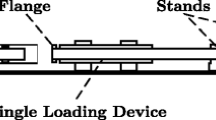Abstract
A novel Kolsky torsion bar technique is developed and successfully utilized to characterize the high strain rate shear response of a rate-independent end-linked polydimethylsiloxane (PDMS) gel rubber with a shear modulus of about10 KPa. The results show that the specimen deforms uniformly under constant strain rate and the measured dynamic shear modulus follows reasonably well the trend determined by dynamic mechanical analysis (DMA) at lower strain rates. For comparison, Kolsky compression bar experiments are also performed on the same gel material with annular disk specimens. The dynamic moduli obtained from compression experiments, however, are an order of magnitude higher than those obtained by the torsional technique, due to the pressure caused by the radial inertia and end constraints.







Similar content being viewed by others
References
Snedeker JG, Niederer P, Schmidlin FR, Farshad M, Demetropoulos CK, Lee JB, Yang KH (2005) Strain-rate dependent material properties of the porcine and human kidney capsule. J Biomech 38:1011–1021
Van Sligtenhorst C, Cronin DS, Wayne Brodland G (2006) High strain rate compressive properties of bovine muscle tissue determined using a split Hopkinson bar apparatus. J Biomech 39:1852–1858
Shim VPW, Liu JF, Lee VS (2006) A technique for dynamic tensile testing of human cervical spine ligaments. Exp Mech 46:77–89
Song B, Chen W, Ge Y, Weerasooriya T (2007) Dynamic and quasi-static compressive response of porcine muscle. J Biomech 40:2999–3005
Singh A, Lu Y, Chen C, Cavanaugh JM (2006) Mechanical properties of spinal nerve roots subjected to tension at different strain rates. J Biomech 39:1669–1676
Pervin F, Chen W (2009) Dynamic mechanical response of bovine gray matter and white matter brain tissues under compression. J Biomech 42:731–735
Pervin F, Chen WW, Weerasooriya T (2010) Dynamic compressive response of renal cortex. International Journal of Structural Changes in Solids-Mechanics and Applications 2:1–7
Chen W, Lu F, Zhou B (2000) A quartz-crystal-embedded split Hopkinson pressure bar for soft materials. Exp Mech 40:1–6
Chen W, Lu F, Frew D, Forrestal M (2002) Dynamic compression testing of soft materials. Trans ASME, J Appl Mech 69:214–223
Song B, Chen W (2004) Dynamic stress equilibration in split Hopkinson pressure bar tests on soft materials. Exp Mech 44:300–312
Song B, Ge Y, Chen W, Weerasooriya T (2007) Radial inertia effects in Kolsky bar testing of extra-soft specimens. Exp Mech 47:659–670
Nie Xu, Song B, Ge Y, Chen W, Weerasooriya T (2009) Dynamic tensile testing of soft materials. Exp Mech 49:451–458
Gorham D (1989) Specimen inertia in high strain-rate compression. J Phys D Appl Phys 22:1888–1893
Forrestal M, Wright T, Chen W (2007) The effect of radial inertia on brittle samples during the split Hopkinson bar pressure bar test. Int J Impact Eng 34:405–411
Warren T, Forrestal M (2009) Comments on the effect of radial inertia in the Kolsky bar test for an incompressible material. Exp Mech, published online
Zhang M, Li Q, Huang F, Wu H, Lu Y (2010) Inertia-induced radial confinement in an elastic tubular specimen subjected to axial strain acceleration. Int J Impact Eng 37:459–464
Song B, Chen W (2005) Split Hopkinson pressure bar techniques for characterizing soft materials. Lat Am J Solid Struct 2:113–152
Donnelly B, Medige J (1997) Shear properties of human brain tissue. J Biomech Eng 119:423–432
Galford JE, McElhaney JH (1970) A viscoelastic study of scalp, brain and dura. J Biomech 3:211–221
Manduca A, Oliphant TE, Dresner MA, Mahowald JL, Kruse SA, Amromin E, Felmlee JP, Ehman RL (2001) Magnetic resonance elastography: non-invasive mapping of tissue elasticity. Med Image Anal 5:237–254
Mendis KK, Stalnaker RL, Advani SH (1995) A constitutive relationship for large deformation finite element modeling of brain tissue. J Biomech Eng 117:279–285
Scheidler M, Raftenberg M, Love B, Kraft R (2009) Inertial effects in numerical simulation of Hopkinson bar tests on nearly compressible soft materials. The joint ASCE-ASME-SES Conference on Mechanics and Materials, Blacksburg, VA
Saraf H, Ramesh KT, Lennon AM, Merkle AC, Roberts JC (2007) Mechanical properties of soft human tissues under dynamic loading. J Biomech 40:1960–1967
Saraf H, Ramesh KT, Lennon AM, Merkle AC, Roberts JC (2007) Measurement of the dynamic bulk and shear response of soft human tissues. Exp Mech 47:439–449
Subhash G, Kwon J (2010) High rate shear response of gelatin. SEM Annual Conference & Exposition on Experimental & Applied Mechanics, IN, June 7–10, (presentation only)
Gilat A (2000) Torsional Kolsky bar testing. ASM Metals Handbook 8:505–515
Kolsky H (1949) An investigation of the mechanical properties of materials at very high rates of loading. Proc Phys Soc London B62:679–700
Clarson SJ, Dodgson K, Semlyen JA (1985) Studies of cyclic and linear poly(dimethylsiloxanes): 19. Glass transition temperatures and crystallization behavior. Polymer 26:930–934
Urayama K, Kawamura T, Kohjiya S (2009) Structure–mechanical property correlations of model siloxane elastomers with controlled network topology. Polymer 50:347–356
Author information
Authors and Affiliations
Corresponding author
Rights and permissions
About this article
Cite this article
Nie, X., Prabhu, R., Chen, W.W. et al. A Kolsky Torsion Bar Technique for Characterization of Dynamic Shear Response of Soft Materials. Exp Mech 51, 1527–1534 (2011). https://doi.org/10.1007/s11340-011-9481-4
Received:
Accepted:
Published:
Issue Date:
DOI: https://doi.org/10.1007/s11340-011-9481-4




